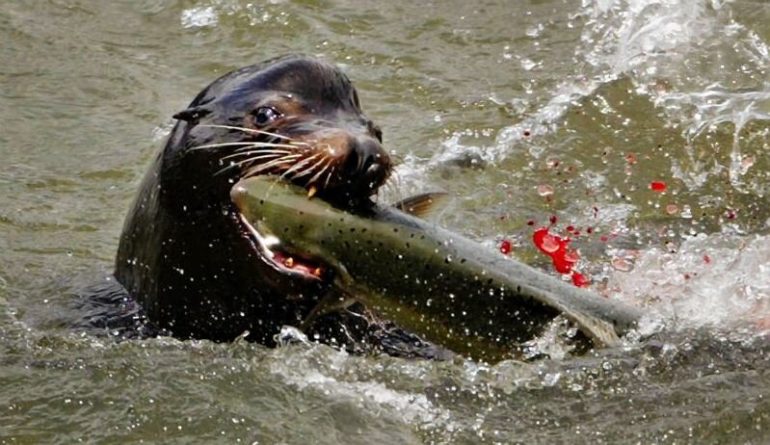The Columbia River is home to one of the West Coast’s most important Chinook salmon runs. Through late spring and early summer, mature fish return from the sea and begin their arduous journey upriver to spawn. In recent years, these fish have faced an additional challenge: hungry California sea lions.
A new University of Washington and NOAA Fisheries study found that sea lions have the largest negative effect on early-arriving endangered Chinook salmon in the lower Columbia River. The results of this study will publish Oct. 18 in the Journal of Applied Ecology.
Opportunistic sea lions have learned that by swimming as far as 145 miles upriver, they can easily feast on migrating salmon, including those hindered by the Bonneville Dam.
“We investigated whether mortality rates varied depending on the specific threatened Chinook salmon population, determined by when they arrive in the river,” said lead author Mark Sorel, a doctoral student at the UW School of Aquatic and Fishery Sciences. “We found that, based on their individual return timing and the abundance of sea lions in the river when they return, individual populations experience different levels of sea lion-associated mortality.”
Researchers learned that the earliest arriving populations of Chinook salmon experienced an additional 20% mortality over previous years, and the later arriving populations experienced an additional 10%. This increase in mortality was associated with increased sea lion abundance at those times of year in the period of 2013 to 2015 compared to the period of 2010 to 2012.
The numbers of California sea lions are highest at the mouth of the Columbia in early spring, before they depart for their breeding grounds in southern California. The researchers also discovered that the earliest arriving salmon migrate through the lower Columbia River more slowly than those arriving later in the season, thereby increasing their exposure to predation.
“This information on how different populations are affected by sea-lion associated mortality is key because recovery of endangered Chinook salmon requires multiple of the individual populations to be healthy,” said Sorel.
California sea lions have seen their numbers rebound along much of the U.S. West Coast since the passage of the Marine Mammal Protection Act of 1972, which protects them from being killed, captured and harassed. The increased presence of sea lions is now at odds with the endangered salmon populations on which they feed, putting managers in a difficult position.
Researchers are concerned that something must be done quickly as these hunting behaviors are learned, and the problem could continue to grow exponentially. In August, the National Marine Fisheries Service granted approval for Washington, Idaho, Oregon and several Pacific Northwest tribes to capture and euthanize both problematic California and Steller sea lions within a larger area of the lower Columbia and Willamette Rivers. Previously, only California sea lions could be killed in these rivers if managers deemed them a threat to salmon.
This complicated decision was enacted after non-lethal methods, such relocation and hazing, to limit the impact sea lions have on salmon—plus some targeted lethal removal—were met with limited success.
“This is often a challenging management problem as both sea lions and salmon are of strong interest to the public, and both are protected under federal statutes,” said Sorel. “Management must consider multiple social values and operate within existing legal frameworks.”
Continued monitoring will help to reduce the remaining uncertainty about the effects of sea lions on salmon and the expected outcomes of alternative management actions.
US allows killing sea lions eating at-risk Northwest salmon
More information:
Mark H. Sorel et al, Estimating population‐specific predation effects on Chinook salmon via data integration, Journal of Applied Ecology (2020). DOI: 10.1111/1365-2664.13772
Provided by
University of Washington
Citation:
Early-arriving endangered Chinook salmon take the brunt of sea lion predation (2020, October 19)
retrieved 19 October 2020
from https://phys.org/news/2020-10-early-arriving-endangered-chinook-salmon-brunt.html
This document is subject to copyright. Apart from any fair dealing for the purpose of private study or research, no
part may be reproduced without the written permission. The content is provided for information purposes only.



